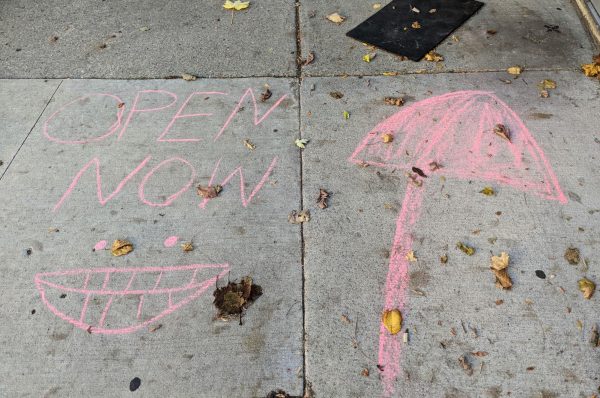Watery yellow light bathed the stone walls and a crowd of punks of the Varsity Theater on Saturday at the second annual Pissfest, creating the feeling of being at the bottom of a toilet bowl.
The self-identified indie bratpunk trio VIAL, hosts of Pissfest, mercifully spared attendees from an olfactory experience but still made the Varsity feel like the grungy punk shows of the past.
A stacked line-up of local favorites and out-of-towners made up the thrash-filled night, interspersed with electrifying drag lip-sync performances by Kenty Poussé Fatale.
“We had a great turnout last year and an even better turnout this year,” said VIAL drummer Katie Fischer. VIAL’s inaugural Pissfest was a single release party for their cover of Nirvana’s “Territorial Pissings” which sold out 7th Street Entry.
University of Minnesota’s own Dial Tone warmed the crowd up with a no-surprises set, concluding with a straightforward cover of “Let’s Go Crazy” by Prince.
Then DIY darling Anita Velveeta showed another side of the Minneapolis sound through screams, crowd surfing and summoning circle pits.
“Wow, there’s a lot of people here!” she said upon taking the stage.
Shouts of “I love you!” rang out from the heart of the pit throughout her set.
Once VIAL and I heard the beginning notes of her final song, “TERFS WILL NOT GET INTO HEAVEN,” rumble above us from their basement dressing room, we pressed pause on our interview to go upstairs and mosh.
Fischer, who uses she/they pronouns, said news of how exciting Pissfest’s first year was quickly spread through the Minneapolis punk scene via word of mouth, and that they’ve even gotten requests to bring Pissfest on the road.
“The future is bright for Pissfest,” she said. Bright yellow.
Last year’s visiting act, Modern Nun, came up the Interstate-94 from Chicago. This year, VIAL’s guests came from even farther east.
Destructo Disk, a three-person punk outfit from Richmond, Virginia, came on after Velveeta’s set and Fatale’s rousing performance of Chappell Roan’s “Pink Pony Club.”
The trio had been supporting VIAL on a Texas tour for the past week before making their pilgrimage to Dinkytown, affectionately referred to by their lead vocalist Gideon Kupka as “Dinkle Town” and “Dinkleburg.”
Destructo Disk brought a hardcore sound with fast, frenetic strumming and throaty screaming with a classic punk flavor.
“All dogs go to heaven and all cops go to hell!” begins the fan favorite “Cops/Dogs.”
Kupka jumped, stomped and prowled across the stage throughout the set, long hair with bleached tendrils evoking the grunge idols that inspired Pissfest.
“I Wish I Was A Riot Grrl” was also received well. After all, what’s a queer punk show without some gender mischief?
New York City-based queer punk band Sorry Mom returned to the Twin Cities, reuniting with Velveeta after sharing the stage with her this September at The Whole Music Club.
The band were naturals in the larger Varsity venue and very much leaned into the piss theme.
Sorry Mom’s lead vocalist Juno Moreno got sprayed with “piss” (water with yellow food coloring) on stage, and started the famed “piss chant” that VIAL mentioned to me earlier.
Moreno’s scratchy screaming was reminiscent of a two-year-old’s tantrum, adding to the youthful anger and playfulness of the band’s sound.
Time away on tour also allowed Moreno to refine the location-specific, spoken-word lyrics of fan favorite “I Fcked Yr Mom.”
“I saw your mom in the Twin Cities. I thought, ‘Now there’s another pair of twins I’d like to get to know,’” Moreno said slyly, grabbing the air’s invisible breasts.
VIAL’s set concluded the night, fronted by guitarist and vocalist KT Branscom along with bassist and vocalist Taylor Kraemer, dressed to the nines in femme-forward gothic outfits that channeled The Hex Girls (or rather, The Hex Theys).
The trio played mostly tracks from their newest EP, “Grow the F-ck Up,” which came out on Nov. 29.
Identifying as bratpunk as well as indie punk rock, their sound draws inspiration from contemporary indie rock as well as riot grrl and grunge.
Speaking of, it was only right for the band to play the song that started it all, their cover of “Territorial Pissings” by Nirvana.
Kupka of Destructo Disk joined VIAL onstage on vocals, emulating Kurt Cobain’s original, roughly melodic vocals.
Cobain wrote the song as a critique of racism and misogyny, centering around the idea of men marking women and people of color as their territory.
It’s fitting for a non-male band to cover a song featuring the lyrics “Never met a wise man / If so, it’s a woman.” Kupka singing those words rang out as a declaration of solidarity and community.
Though Pissfest was their first meeting, Kupka and the members of VIAL thrashed together on stage with the energy of old friends.
Kraemer said community is the biggest thing VIAL wants people to take away from Pissfest.
VIAL’s commitment to the community goes beyond playing music, too. Twin Cities Trans Mutual Aid set up a table near the merch tables, offering pay-what-you-can patches and pins, free Narcan and information about community events.
“We’re big fans of what they do for our community, so we thought, ‘What better place to help promote what they do than Pissfest, where so many queer and trans people are congregating,’” Branscom said.
Ultimately, Pissfest is the Twin Cities punk scene’s communion at the bottom of a toilet bowl, a space created to embrace our filth together.

